|
| |
2005 Newsroom Archives
National Media Liaisons:
Terry Bish, 202-720-3210
Mary Cressel, 202-690-0547
State News and Public Affairs Contacts
Where to Get Information About NRCS
USDA Authorizes Rehabilitation of Three Virginia Dams
 |
| USDA-NRCS will use Watershed
Protection and Flood Prevention Program funds to rehabilitate Robinson
Hollow Dam in Augusta County, Va. |
Dec. 7, 2005- Natural Resources Conservation Service (NRCS) Chief Bruce
Knight today authorized federal assistance for the rehabilitation of three dams
in Virginia at an estimated cost of $4.1 million. The work performed on these
dams will ensure the projects continue to serve Virginia residents safely for
the next 50 years. The projects in this announcement are Robinson Hollow Dam,
Thomas Branch Dam and Inch Branch Dam in the South River Watershed in Augusta
County, Va.The Federal Government will pay 65 percent of the total cost of the
projects.
NRCS news release: "USDA Authorizes
Rehabilitation of Three Virginia Dams" (Dec. 7, 2005)
en Español
Watershed Protection and Flood
Prevention
NRCS Virginia
Johanns Announces Nearly $2.7 Billion for Voluntary Conservation Programs on
Working Lands
 |
| Contour stripcropping helps
protect this farm in Maryland from erosion. |
Dec. 1, 2005—Agriculture Secretary Mike Johanns today announced the release
of nearly $2.7 billion in fiscal year 2006 for voluntary programs on working
lands. This year’s allocation includes nearly $1.3 billion in technical
assistance and about $1.4 billion in financial assistance for NRCS voluntary
conservation programs and other activities. A total of more than $2.3 billion
will be distributed to the 50 states, Puerto Rico and the Pacific Basin.
Links…
 news release:
“Johanns Announces Nearly $2.7 Billion for Voluntary Conservation Programs on
Working Lands” (Dec. 1, 2005)
en Español news release:
“Johanns Announces Nearly $2.7 Billion for Voluntary Conservation Programs on
Working Lands” (Dec. 1, 2005)
en Español
Conservation Programs
Watershed Assistance Authorized in Four States
 Nov.
8, 2005—USDA authorized federal assistance for local flood control and watershed
rehabilitation efforts in Georgia, Mississippi, Oklahoma and Texas. Eligible
measures include flood prevention, water conservation, recreation, agricultural
water management, floodplain easements, municipal and industrial water, and
rural water supply. USDA will pay 65 percent of the total cost of each project. Nov.
8, 2005—USDA authorized federal assistance for local flood control and watershed
rehabilitation efforts in Georgia, Mississippi, Oklahoma and Texas. Eligible
measures include flood prevention, water conservation, recreation, agricultural
water management, floodplain easements, municipal and industrial water, and
rural water supply. USDA will pay 65 percent of the total cost of each project.
Links…
NRCS news release: “USDA Authorizes
Watershed Assistance in Four States” (Nov. 8, 2005)
en Español
Watershed Rehabilitation Information
Watershed Protection and Flood
Prevention
NRCS Announces 1st Youth Environmental Awards Winners with
4-H and Supports FFA Career Development
 |
| Photo courtesy of National 4-H
Youth Development Program |
Nov. 3, 2005— NRCS congratulates the winners of the 1st Youth Environmental
Awards, funded as part of a $50,000 grant to 4-H to promote conservation among
4-H youth and in state programs. The awards recognize state programs that
promote conservation in relationship to water, soil and /or atmospheric
resources, grazing land and forestry or wildlife habitat. The first winners of
the NRCS Youth Environmental Awards are Michigan 4-H Youth Conservation Council;
4-H Wildlife Stewards, Multnomah County, Ore.; and South Carolina State 4-H
Program, 4-H20 Pontoon Classroom, Clemson, S.C.
Oct. 28, 2005—NRCS provided a $50,000 grant to the FFA organization to help
support the National FFA Career Development Events program which fosters and
recognizes excellence in agriculture learning with a goal of inspiring young
people to consider careers in agricultural business and industry.
Links…
NRCS news release: “USDA Announces First Youth
Environmental Awards Winners; Awards Program Funded by $50,000 Grant” (Nov.
3, 200 5)
 news release: “Johanns Announces $150,000 in Grants to FFA for Agricultural Education”
(Oct. 28, 2005) news release: “Johanns Announces $150,000 in Grants to FFA for Agricultural Education”
(Oct. 28, 2005)
Ag Air Quality Task Force to Meet in Hawaii
 Nov.
1, 2005—The next meeting of the USDA-Agricultural Air Quality Task Force will be
Nov. 13-15, 2005, in Wailea-Maui, Hawaii. The meeting is open to the public
beginning at 8 a.m. for a full day on Sunday, Nov. 13, and on Tuesday, Nov. 15.
Public comments will be accepted each day. The task force meeting brings
attention to the regional nature of ag air quality issues and Hawaii’s unique
concerns of haze and diminished visibility of pristine areas. This meeting is
being held in conjunction with USDA’s Farm Bill Listening Forum, Nov. 12, in
Kona, Hawaii. Nov.
1, 2005—The next meeting of the USDA-Agricultural Air Quality Task Force will be
Nov. 13-15, 2005, in Wailea-Maui, Hawaii. The meeting is open to the public
beginning at 8 a.m. for a full day on Sunday, Nov. 13, and on Tuesday, Nov. 15.
Public comments will be accepted each day. The task force meeting brings
attention to the regional nature of ag air quality issues and Hawaii’s unique
concerns of haze and diminished visibility of pristine areas. This meeting is
being held in conjunction with USDA’s Farm Bill Listening Forum, Nov. 12, in
Kona, Hawaii.
Links…
NRCS news release: “Agricultural Air
Quality Task Force to Meet in Hawaii; Open to the Public on November 13 and 15,
2005” (Nov. 1, 2005)
USDA-Agricultural Air
Quality Task Force
NRCS Joins “Walk a Mile in My Boots”
 Oct.
24 , 2005—NRCS is working with the National Association of Conservation
Districts to participate in the “Walk a Mile in My Boots” initiative, a
work-exchange program between agricultural producers and government employees
that was developed by the National Cattlemen’s Beef Association and U.S. Fish
and Wildlife Service. Initial participation will involve up to 10 pilot
exchanges in Arizona, California, Colorado, New Mexico and Utah. Oct.
24 , 2005—NRCS is working with the National Association of Conservation
Districts to participate in the “Walk a Mile in My Boots” initiative, a
work-exchange program between agricultural producers and government employees
that was developed by the National Cattlemen’s Beef Association and U.S. Fish
and Wildlife Service. Initial participation will involve up to 10 pilot
exchanges in Arizona, California, Colorado, New Mexico and Utah.
Links…
NRCS news release: “USDA Joins “Walk a
Mile in My Boots” Initiative” (Oct. 24 , 2005)
en Español
Walk a Mile in My Boots
Initiative
ACES is NRCS’ New Partnership with the National Older Worker
Career Center
 Oct.
24, 2005—The Agricultural Conservation Enrollees/Seniors (ACES) pilot project is
a new initiative of NRCS and the National Older Worker Career Center (NOWCC) to
obtain the services of experienced workers on a temporary basis. The ACES pilot
is underway in Colorado, Georgia, Kansas, Minnesota, Mississippi, Utah and
Virginia, as well as the NRCS West National Technology Support Center in
Portland, Ore., and NRCS national headquarters in Washington, D.C. About half of
the 36 positions identified for the pilot have been filled. NOWCC, a nonprofit
organization focused on employment opportunities and issues for older workers,
posts ACES positions on its website, screens the applicants and forwards
qualified ones to NRCS for interviews. Oct.
24, 2005—The Agricultural Conservation Enrollees/Seniors (ACES) pilot project is
a new initiative of NRCS and the National Older Worker Career Center (NOWCC) to
obtain the services of experienced workers on a temporary basis. The ACES pilot
is underway in Colorado, Georgia, Kansas, Minnesota, Mississippi, Utah and
Virginia, as well as the NRCS West National Technology Support Center in
Portland, Ore., and NRCS national headquarters in Washington, D.C. About half of
the 36 positions identified for the pilot have been filled. NOWCC, a nonprofit
organization focused on employment opportunities and issues for older workers,
posts ACES positions on its website, screens the applicants and forwards
qualified ones to NRCS for interviews.
Links…
NRCS news release: “USDA Announces New
Partnership with the National Older Worker Career Center” (Oct. 24, 2005)
en Español
National Older Worker Career Center
ACES positions
(see USDA National Corps of Experienced Professionals-NCEP)
Nearly $1.7 Billion Available for Voluntary Conservation
Programs
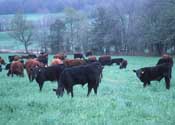 Oct.
14, 2005—At the Farm Bill Listening Forum in Little Rock, Ark., Agriculture
Deputy Secretary Chuck Conner announced the release of nearly $1.7 billion in
fiscal year 2006 funding for voluntary conservation farm bill programs on
working lands. Fiscal year 2006 allocations include $1.345 billion in financial
assistance and $337 million for technical assistance for NRCS voluntary
conservation programs. States will receive additional money after Congress makes
final funding decisions through the fiscal year 2006 appropriations process. Oct.
14, 2005—At the Farm Bill Listening Forum in Little Rock, Ark., Agriculture
Deputy Secretary Chuck Conner announced the release of nearly $1.7 billion in
fiscal year 2006 funding for voluntary conservation farm bill programs on
working lands. Fiscal year 2006 allocations include $1.345 billion in financial
assistance and $337 million for technical assistance for NRCS voluntary
conservation programs. States will receive additional money after Congress makes
final funding decisions through the fiscal year 2006 appropriations process.
Key voluntary conservation programs and allocations include:
Environmental Quality Incentives Program--$1,017,000,000
Ground and Surface Water Conservation--$51,000,000
Klamath Basin--$8,118,000
Wetlands Reserve Program--$245,704,302
Farm and Ranch Lands Protection Program--$73,500,000
Wildlife Habitat Incentives Program--$43,000,000
Conservation Security Program--$245,000,000
Links…
 news release:
“USDA Announces $1.7 Billion for Voluntary Conservation Programs on Working
Lands” (Oct. 14, 2005)
en Español news release:
“USDA Announces $1.7 Billion for Voluntary Conservation Programs on Working
Lands” (Oct. 14, 2005)
en Español
NRCS conservation programs
USDA and USDI Sign Partnership Agreement Regarding Water Conservation
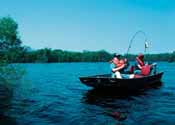 Oct. 12, 2005 – NRCS Chief Bruce Knight and John W. Keys, III, Commissioner,
Bureau of Reclamation, signed a five-year memorandum of understanding (MOU) to
accomplish efficient use and long-term sustainability of available water
supplies for agricultural production, fish and wildlife protection, recreation
and other beneficial uses. The states in the MOU are Arizona, California,
Colorado, Idaho, Kansas, Montana, Nebraska, Nevada, New Mexico, North Dakota,
Oklahoma, Oregon, South Dakota, Texas, Utah, Washington and Wyoming. Oct. 12, 2005 – NRCS Chief Bruce Knight and John W. Keys, III, Commissioner,
Bureau of Reclamation, signed a five-year memorandum of understanding (MOU) to
accomplish efficient use and long-term sustainability of available water
supplies for agricultural production, fish and wildlife protection, recreation
and other beneficial uses. The states in the MOU are Arizona, California,
Colorado, Idaho, Kansas, Montana, Nebraska, Nevada, New Mexico, North Dakota,
Oklahoma, Oregon, South Dakota, Texas, Utah, Washington and Wyoming.
Links...
NRCS
news release: "USDA and USDI Sign Partnership Agreement Regarding Water
Conservation" (Oct. 12, 2005)
en Español
NRCS-Bureau of Reclamation memorandum of
understanding
Bureau of Reclamation
USDA Awards $12.6 Million for Biomass Research and
Development
 |
| Credit: Dept. of Energy,
National Renewable Energy Lab |
Oct. 6, 2005—Eleven projects have been selected to receive $12.6 million through
the joint USDA-Dept. of Energy Biomass Research and Development Initiative. The
total value of the projects is nearly $19 million, including cost sharing of the
private-sector partners. More than 670 applications, divided into four unique
technical topic areas, were submitted for the 2005 joint solicitation. Winning
projects are listed in the news release.
Links…
 news release: “USDA Awards
$12.6 Million for Biomass Research and Development” (Oct. 6, 2005)
en Español news release: “USDA Awards
$12.6 Million for Biomass Research and Development” (Oct. 6, 2005)
en Español
Biomass Research and Development
Initiative
Energy and Agriculture
Recipients of the
Biomass R & D Initiatives FY 2005 Joint Solicitation
Conservation Planning Sign-Up Pilot Announced
 Sept. 22, 2005—Nine states are participating in NRCS’ first conservation
planning sign-up, a pilot initiative that emphasizes the importance of
conservation planning to help producers be better prepared to apply for
conservation programs and to comply with federal, state, tribal and local
governmental regulations. The sign-up will enable landowners to plan more
realistically to implement practices and apply for conservation programs in a
more comprehensive approach. The states and sign-up dates are: Sept. 22, 2005—Nine states are participating in NRCS’ first conservation
planning sign-up, a pilot initiative that emphasizes the importance of
conservation planning to help producers be better prepared to apply for
conservation programs and to comply with federal, state, tribal and local
governmental regulations. The sign-up will enable landowners to plan more
realistically to implement practices and apply for conservation programs in a
more comprehensive approach. The states and sign-up dates are:
|
State |
2005 Sign- Up Date |
|
Start |
End |
| California |
Oct. 1 |
Dec. 31 |
| Colorado |
Sept. 19 |
Nov. 1 |
| North Dakota |
Oct. 3 |
Nov. 18 |
| Oklahoma |
Oct. 17 |
Nov. 18 |
| Oregon |
Sept. 1 |
Sept. 30 |
| Pennsylvania |
Sept. 18 |
Nov. 23 |
| Rhode Island |
Sept. 6 |
Nov. 10 |
| Texas |
Sept. 26 |
Nov. 28 |
| Wyoming |
Oct. 3 |
Nov. 18 |
Links…
 news release:
“USDA Announces Conservation Planning Sign-Up Pilot” (Sept. 22, 2005)
news release:
“USDA Announces Conservation Planning Sign-Up Pilot” (Sept. 22, 2005)
Conservation Planning Assistance
Conservation Technical Assistance
USDA Prepares for Hurricane Rita and Highlights Hurricane Katrina Recovery
Efforts
 |
| Sand removal and relocation is
an issue in Gulf Shores, Ala. |
Sept. 22, 2005—As part of USDA’s hurricane relief efforts, NRCS maps have been
used by first responders to assess ground conditions during the search and
rescue of survivors. Current satellite and airborne imagery is being used to
locate possible dangers, such as fires, and the safest route to rescue
survivors. Soil survey data layers are being used to locate the best areas for
animal debris disposal and burial that will not endanger water sources. Through
the Emergency Watershed Protection Program, approximately $17.4 million is
available for Hurricane Katrina relief efforts. NRCS continues to work with
other USDA agencies, FEMA and state emergency agencies to assist with
post-disaster cleanup and restoration projects in Louisiana, Florida,
Mississippi and Alabama.
Links…
 news release:
“USDA Prepares for Hurricane Rita; USDA Highlights Assistance to Regions
Affected by Hurricane Katrina” (Sept. 22, 2005)
news release:
“USDA Prepares for Hurricane Rita; USDA Highlights Assistance to Regions
Affected by Hurricane Katrina” (Sept. 22, 2005)
NRCS Hurricane Katrina Aftermath Information
Emergency Watershed Protection Program
Nearly $30 Million Available to Landowners for Voluntary Conservation Programs
 Aug.
29, 2005—At the White House Conference on Cooperative Conservation in St Louis,
Mo., Agriculture Secretary Mike Johanns announced that nearly $30 million in
cost-share assistance, incentive payments and technical assistance has been made
available for voluntary conservation programs on private, agricultural and other
nonfederal lands. NRCS is making the funding available by reallocating funds at
the state level and redistributing unused funds from national level projects.
Because of this funding, more landowners are able to participate in cooperative
conservation in partnership with NRCS to put conservation on the land and help
the environment. A state-by-state list of the reallocated funds is available at
the link indicated below. Aug.
29, 2005—At the White House Conference on Cooperative Conservation in St Louis,
Mo., Agriculture Secretary Mike Johanns announced that nearly $30 million in
cost-share assistance, incentive payments and technical assistance has been made
available for voluntary conservation programs on private, agricultural and other
nonfederal lands. NRCS is making the funding available by reallocating funds at
the state level and redistributing unused funds from national level projects.
Because of this funding, more landowners are able to participate in cooperative
conservation in partnership with NRCS to put conservation on the land and help
the environment. A state-by-state list of the reallocated funds is available at
the link indicated below.
Key voluntary conservation programs and financial assistance available are:
Environmental Quality Incentives Program--$25,973,658
Ground and Surface Water Conservation--$137,000
Farm and Ranch Lands Protection Program--$483,458
Grassland Reserve Program--$1,401,190
Wildlife Habitat Incentives Program--$767,896
Wetlands Reserve Program--$1,060,000
Agricultural Management Assistance--$34,040
Links…
 news release:
“Johanns Advances President’s Cooperative Conservation Vision at Historic White
House Conference” (Aug. 29, 2005)
news release:
“Johanns Advances President’s Cooperative Conservation Vision at Historic White
House Conference” (Aug. 29, 2005)
State-by-State Reallocation List (8/05)
NRCS voluntary conservation programs
NRCS Chief Bruce Knight’s statement on
cooperative conservation
USDA Announces First Tribal Conservation District in Alaska
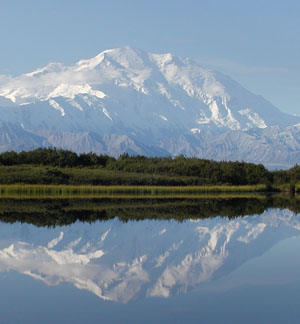 August 25, 2005 – USDA announced the first-ever Tribal Conservation District in
Alaska. Formed through a cooperative conservation agreement between the US
Department of Agriculture, Tyonek Native Corporation and the Native Village of
Tyonek, this will be the 26th Tribal Conservation District organized by USDA and
the first federally-designated district in Alaska; 12 existing soil and water
conservation districts are state-affiliated. The Tyonek Tribal Conservation
District joins a host of Indian tribes that have elected to form
officially-recognized tribal conservation districts to maintain cooperative
conservation relationships with USDA. August 25, 2005 – USDA announced the first-ever Tribal Conservation District in
Alaska. Formed through a cooperative conservation agreement between the US
Department of Agriculture, Tyonek Native Corporation and the Native Village of
Tyonek, this will be the 26th Tribal Conservation District organized by USDA and
the first federally-designated district in Alaska; 12 existing soil and water
conservation districts are state-affiliated. The Tyonek Tribal Conservation
District joins a host of Indian tribes that have elected to form
officially-recognized tribal conservation districts to maintain cooperative
conservation relationships with USDA.
Links…
 news release:
“USDA Announces First Tribal Conservation District in Alaska” (Aug. 25,
2005)
news release:
“USDA Announces First Tribal Conservation District in Alaska” (Aug. 25,
2005)
NRCS Provides More Than $19 Million for Conservation Technologies and Approaches
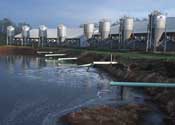 |
| Lagoon waste management system in
Georgia. |
Aug. 24, 2005—NRCS announced that 54 projects in 40 states and Guam will receive more
than $19 million in National and Chesapeake Bay Watershed Conservation
Innovation Grants. These grants will fund the development and adoption of
innovative technologies and approaches through pilot projects and conservation
field trials. Selected projects address issues such as agricultural air
emissions, water quality improvement, water conservation, livestock nutrient
management and market-based approaches to conservation. Of the total amount of
the grants, more than $4.5 million will fund 12 projects that address natural
resource concerns in the Chesapeake Bay Watershed.
Links…
NRCS news release: “USDA Provides More Than $19 Million to Fund Conservation
Technologies and Approaches; National and Chesapeake Bay Watershed Conservation
Innovation Grants Awarded” (Aug. 24, 2005)
Conservation Innovation Grants
Proposals Selected for Wetlands Reserve Enhancement
Program to Receive Nearly $4.2 Million
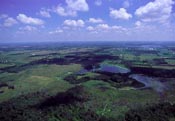 |
| Credit: Indiana Wetlands
website, IN Dept. of Natural Resources |
Aug. 18, 2005—USDA announced that nine partnership proposals will receive nearly
$4.2 million through the Wetlands Reserve Enhancement Program (WREP) to restore,
enhance, protect and manage habitat for migratory birds and other
wetland-dependent wildlife. Of this $4.2 million, $112,484 will fund partnership
proposals that address bog turtle habitat in the east and $800,000 for
Ivory-billed woodpecker habitat in Arkansas. Proposals were selected from
Arkansas (2), Indiana (2), Iowa, Louisiana/Mississippi, New Jersey, Pennsylvania and
Washington.
Links…
 news release:
“USDA Selects proposals for Wetlands Reserve Enhancement program; Nearly $4.2
Million Available for the Program in Fiscal Year 2005” (Aug. 18, 2005) news release:
“USDA Selects proposals for Wetlands Reserve Enhancement program; Nearly $4.2
Million Available for the Program in Fiscal Year 2005” (Aug. 18, 2005)
Wetlands Reserve Program
NRCS Launches Web Soil Survey
 Aug.
16, 2005—NRCS announced the new Web Soil Survey site that will provide public
access to the national soils information system. Soil survey maps and related
information enable everyone from agricultural producers, conservationists,
engineering firms, county and city planners and others to make informed land use
decisions. The site operates similar to Internet sites that provide locator and
directional information. Currently, NRCS has soil maps and data available online
for more than 95 percent of the nation’s counties. Aug.
16, 2005—NRCS announced the new Web Soil Survey site that will provide public
access to the national soils information system. Soil survey maps and related
information enable everyone from agricultural producers, conservationists,
engineering firms, county and city planners and others to make informed land use
decisions. The site operates similar to Internet sites that provide locator and
directional information. Currently, NRCS has soil maps and data available online
for more than 95 percent of the nation’s counties.
Links…
 news release:
“USDA Announces Web Soil Survey; Internet-based System Allows Users Access to
Soil Survey Information” (Aug. 16, 2005) news release:
“USDA Announces Web Soil Survey; Internet-based System Allows Users Access to
Soil Survey Information” (Aug. 16, 2005)
Web Soil Survey
http://soils.usda.gov/survey
Statement by NRCS Chief Bruce Knight on WRP
 |
| J.B. Martin, NRCS District
Conservationist, discusses wetlands conservation practices with landowners
Louis and Mary Lou Peterson on their farm near Iowa City, IA. |
August 15, 2005— Wetlands provide all Americans tremendous environmental
benefits including flood prevention, nutrient and sediment reduction for better
water quality, wildlife habitat improvement, carbon sequestration, and open
space. The Wetlands Reserve Program restores, enhances, and creates wetlands in
areas of marginal farmlands. Between 1997 and 2003, agricultural producers
across the nation achieved an average net gain of 44,000 acres of wetlands each
and every year. Producers who participate in USDA programs have proven
themselves good stewards of the land, and NRCS local offices are working closely
with them to improve our nation’s wetlands.
Net Wetlands
Change Due to Agriculture, 1997 – 2003
|
Time Period |
Total Net
Change |
Annual
Average Net Change |
|
1997 - 2001 |
+132,000 Acres |
+33,000
Acres/Year |
|
2001 - 2003 |
+131,000 Acres |
+66,000
Acres/Year |
|
1997 - 2003 |
+263,000 Acres |
+44,000
Acres/Year |
NRCS is committed to streamlining and improving our programs to gain
efficiencies and give American taxpayers the best value for their investment.
Based on USDA National Agriculture Statistics Service data, agricultural values
have increased 39 percent every five years since 1995. This year, farmland with
potential for immediate development value is approximately $6,000 per acre. The
2005 agricultural value is approximately $1,500 per acre. NRCS recognizes our
fiscal responsibility to ensure taxpayers that they are receiving high quality
natural resource benefits at a reasonable cost while providing clean water,
clean air, and abundant wildlife habitat.
Links...
NRCS news release: “NRCS Data Show
Significant Gains in Agricultural Wetland Acreage” (March 31, 2005)
en Español
Wetlands Reserve Program
NRCS Announces Tribal and Asian Pacific Islander
Scholarship Recipients
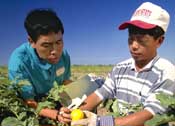 Aug.
12, 2005—NRCS announced the 2005 scholarship recipients in the Tribal
Scholars Program and Asian Pacific Islander Scholars Program for the coming
school year. Five scholars in each program will receive financial assistance
from NRCS to study agriculture and related natural resource sciences at a 1994
tribal land-grant institution or university with a high percentage of Asian and
Pacific Islander students in California, Hawaii, Minnesota, Wisconsin or the
Pacific Basin. Agriculture Secretary Mike Johanns made the announcement during a
visit in Fresno with the African American Farmers of California. Aug.
12, 2005—NRCS announced the 2005 scholarship recipients in the Tribal
Scholars Program and Asian Pacific Islander Scholars Program for the coming
school year. Five scholars in each program will receive financial assistance
from NRCS to study agriculture and related natural resource sciences at a 1994
tribal land-grant institution or university with a high percentage of Asian and
Pacific Islander students in California, Hawaii, Minnesota, Wisconsin or the
Pacific Basin. Agriculture Secretary Mike Johanns made the announcement during a
visit in Fresno with the African American Farmers of California.
Links…
NRCS news release:
“USDA Announces Recipients of Tribal and Asian Pacific
Islander Scholarships for 2005” (Aug. 12, 2005)
Scholarships from NRCS
USDA Signs Agreement with Certified Professional in
Erosion and Sediment Control, Inc.
 |
| NRCS Chief Bruce Knight
(left) and CPESC Executive Director David Ward sign three-year
agreement. |
|
Aug. 2, 2005 - USDA signed an agreement today with CPESC that will allow farmers
and ranchers who need technical assistance with soil erosion and sediment
control and storm water quality to obtain that assistance from certified
technical service providers (TSPs) or third-party vendors. NRCS Chief Bruce
Knight and CPESC Executive Director David Ward signed a three-year memorandum of
understanding during the Soil and Water Conservation Society’s annual
conference. CPESC’s experts will be able to help private landowners plan, design
and implement conservation practices such as buffers, conservation tillage,
vegetative land stabilization and channel and stream stabilization.
Links...
NRCS news release: "USDA Signs Technical Service Provider Agreement With
Certified Professional in Erosion and Sediment Control, Inc." (Aug. 2, 2005)
Technical Service Provider Assistance
Information
Certified Professional in Erosion and Sediment
Control
USDA Announces 2005 CSP Contracts
 July
25, 2005— NRCS will offer 12,700 Conservation Security Program contracts across
the nation. These 2005 contracts being offered translate into more than a $1
billion long-term commitment to conservation over the next 10 years. The CSP
contracts offered cover about 9 million acres of private land in the 220
watersheds selected for this year’s program. July
25, 2005— NRCS will offer 12,700 Conservation Security Program contracts across
the nation. These 2005 contracts being offered translate into more than a $1
billion long-term commitment to conservation over the next 10 years. The CSP
contracts offered cover about 9 million acres of private land in the 220
watersheds selected for this year’s program.
Links…
 news release:
“USDA Announces 2005 Conservation Security Program Contracts” (July 25,
2005) news release:
“USDA Announces 2005 Conservation Security Program Contracts” (July 25,
2005)
Conservation Security Program
NRCS Provides $5 Million to Restore and Protect Wetlands
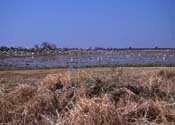 July
19, 2005—NRCS is providing $5 million in Wetlands Reserve Program funding for
restoration activities in 20 states to restore and protect nearly 40,000 acres
of wetlands. States receiving the funds are California, Delaware, Idaho,
Illinois, Iowa, Louisiana, Maryland, Michigan, Minnesota, Mississippi, Missouri,
Nebraska, New York, North Carolina, Ohio, Oklahoma, South Carolina, Tennessee,
Texas and Vermont. July
19, 2005—NRCS is providing $5 million in Wetlands Reserve Program funding for
restoration activities in 20 states to restore and protect nearly 40,000 acres
of wetlands. States receiving the funds are California, Delaware, Idaho,
Illinois, Iowa, Louisiana, Maryland, Michigan, Minnesota, Mississippi, Missouri,
Nebraska, New York, North Carolina, Ohio, Oklahoma, South Carolina, Tennessee,
Texas and Vermont.
Links…
 news
release:
"USDA Releases $5 Million to Restore and Protect Wetlands in 20 States" (July
19, 2005) news
release:
"USDA Releases $5 Million to Restore and Protect Wetlands in 20 States" (July
19, 2005)
Wetlands Reserve Program
USDA Reallocates Nearly $12 Million to Protect Agricultural
Land in 22 States
 |
| This hillside vineyard in
Sonoma Valley, Calif., is protected from nonagricultural uses through FRPP. |
July 14, 2005— NRCS is reallocating nearly $12 million to help agricultural
producers in 22 states protect their working lands through the Farm and Ranch
Lands Protection Program (FRPP). The reallocation resulted from unused funds
previously distributed to NRCS state offices earlier in fiscal year 2005. FRPP
funds will help purchase conservation easements in AL, CA, CO, FL, GA, IA, KY,
MD, MI, MN, NM, NY, NC, OH, OR, PA, SD, UT, VA, WA, WI and WY.
Links…
 news release:
“USDA
Reallocates Nearly $12 Million To Protect Agricultural Land in 22 States From
Development” (July 14, 2005) news release:
“USDA
Reallocates Nearly $12 Million To Protect Agricultural Land in 22 States From
Development” (July 14, 2005)
Farm and Ranch Lands Protection Program
NRCS Provides $5 Million for Sage Grouse Conservation
in 11 States
 |
| U.S. Fish and Wildlife Service,
Dave Menke |
July 13, 2005—NRCS is providing $5 million for special projects to protect and
enhance Greater sage grouse habitat in California, Colorado, Idaho, Montana,
Nevada, North Dakota, Oregon, South Dakota, Utah, Washington and Wyoming. The
funds will be available through the Grassland Reserve Program, Wildlife Habitat
Incentives Program and Environmental Quality Incentives Program.
Links…
 news release:
“USDA Provides $5 Million for Sage Grouse Conservation and
Recovery in 11 States” (July 13, 2005) news release:
“USDA Provides $5 Million for Sage Grouse Conservation and
Recovery in 11 States” (July 13, 2005)
Grassland Reserve Program
Wildlife Habitat Incentives Program
Environmental Quality Incentives Program
NRCS and Army Corps of Engineers Enter Agreement
 July
7, 2005—NRCS signed a partnership agreement with the Office of the Assistant
Secretary of the Army (Civil Works) to improve management of the nation’s water and related natural
resources. The agreement enables the two agencies to work together in areas of
mutual interest including wetlands conservation compliance and regulation;
wetland creation, restoration and enhancement; natural disaster recovery; and
watershed planning and implementation. July
7, 2005—NRCS signed a partnership agreement with the Office of the Assistant
Secretary of the Army (Civil Works) to improve management of the nation’s water and related natural
resources. The agreement enables the two agencies to work together in areas of
mutual interest including wetlands conservation compliance and regulation;
wetland creation, restoration and enhancement; natural disaster recovery; and
watershed planning and implementation.
Links…
NRCS news release: “Agriculture and Army Sign Partnership Agreement” (July 7, 2005)
NRCS voluntary conservation programs
U.S. Army Corps of Engineers
NRCS Deputy Chief Named President-Elect of Executive Women
in Government
 |
| (from left) the Honorable
Sandra Day O'Connor swears in Maria Parisi Vickers, Esq. and Kathy Gugulis
as outgoing president Lori Santamorena looks on. |
NRCS Deputy Chief Named President-Elect of Executive Women in Government
June 17 --Kathy Gugulis, NRCS Deputy Chief for Strategic Planning and
Accountability, has been named President-Elect of Executive Women in Government
(EWG). She was sworn in at a June 14 ceremony at the Supreme Court presided by
founding member Hon. Sandra Day O’Connor. EWG was formed in 1974 by a group of
women who were concerned about the small percentage of women in leadership
positions in the Federal government. In 1974 there were less than 100 women in
senior positions. Today, female career Senior Executive Service personnel number
around 1,500.
Links...
NRCS news release: “NRCS Deputy Chief Named
President-Elect of Executive Women in Government” (June 17, 2005)
Executive Women in Government
NRCS Signs Agreement with American Forage and
Grassland Council
 |
| AFGC President Ed Twidwell
(left) and NRCS Chief Bruce Knight sign MOU. |
June
14, 2005—NRCS signed a memorandum of understanding (MOU) with the American
Forage and Grassland Council (AFGC), giving conservation program participants
the option to obtain technical assistance for their privately-owned grazing and
tribal lands from certified technical service providers who also are certified
grassland professionals. NRCS Chief Bruce Knight and AFGC President Ed Twidwell
signed the three-year agreement during the 2005 AFGC Conference in Bloomington,
Ill. The MOU allows AFGC to recommend its members, who must pass a test, to NRCS
for certification to plan and implement conservation practices on pasture,
hayland and grazed cropland.
Links…
NRCS news release: “USDA Signs Technical Service Provider Agreement with the
American Forage and Grassland Council” (June 14, 2005)
en Español
Technical Service Provider Assistance
Information
American Forage and Grassland Council
NRCS Provides $104.5 Million for Natural Disaster
Recovery in 15 States
 June
8, 2005—NRCS is providing $104.5 million in Emergency Watershed Protection
Program funding for locally-sponsored watershed protection projects resulting
from floods and other natural disasters such as tornadoes, fires, drought and
hurricanes. States receiving the emergency funding are Alabama, Arizona,
California, Florida, Hawaii, Massachusetts, Mississippi, New Mexico, New York,
Ohio, Oklahoma, Pennsylvania, Tennessee, Utah and Washington. These funds were
provided through a supplemental appropriation. June
8, 2005—NRCS is providing $104.5 million in Emergency Watershed Protection
Program funding for locally-sponsored watershed protection projects resulting
from floods and other natural disasters such as tornadoes, fires, drought and
hurricanes. States receiving the emergency funding are Alabama, Arizona,
California, Florida, Hawaii, Massachusetts, Mississippi, New Mexico, New York,
Ohio, Oklahoma, Pennsylvania, Tennessee, Utah and Washington. These funds were
provided through a supplemental appropriation.
Links…
 news release:
“USDA
Provides $104.5 Million for Natural Disaster Recovery in 15 States” (June 8,
2005)
en Español news release:
“USDA
Provides $104.5 Million for Natural Disaster Recovery in 15 States” (June 8,
2005)
en Español
Emergency Watershed Protection Program
Conservation Security Program 2005 Sign-Up Closes
May 27
 May
26, 2005—NRCS reminds producers that the sign-up period for the 2005
Conservation Security Program ends Friday, May 27. This nationwide sign-up that
began March 28 is available to approximately 235,000 farmers and ranchers in 220
selected watershed locations. In order to apply for CSP, producers should
contact the local NRCS office to actually sign-up for the program. Interested
producers can sign onto a 2005 CSP Sign-up Register in situations where NRCS is
unable to complete the one-on-one sign-up interview by this Friday. May
26, 2005—NRCS reminds producers that the sign-up period for the 2005
Conservation Security Program ends Friday, May 27. This nationwide sign-up that
began March 28 is available to approximately 235,000 farmers and ranchers in 220
selected watershed locations. In order to apply for CSP, producers should
contact the local NRCS office to actually sign-up for the program. Interested
producers can sign onto a 2005 CSP Sign-up Register in situations where NRCS is
unable to complete the one-on-one sign-up interview by this Friday.
Links...
 news release:
"USDA Announces Closing Of 2005 Sign-Up For Conservation Security Program" (May 26, 2005) news release:
"USDA Announces Closing Of 2005 Sign-Up For Conservation Security Program" (May 26, 2005)
Conservation Security Program
Three NRCS Soil Scientists Receive National
Recognition
 May 24, 2005—Anthony Khiel, Douglas Thomas and Dr. Neil Smeck were presented
awards by Chief Bruce Knight at the National Cooperative Soil Survey (NCSS) conference in Corpus Christi,
Texas, today.
Khiel and Thomas were co-recipients of the NCSS Soil Scientist of the Year Award
and Dr. Smeck, professor of soil science at Ohio State University, received the
NCSS Cooperator Achievement Award.
William “Rob” Knight also was honored with the NCSS Soil Scientist Achievement
Award in recognition for many years of work.
He will receive his award at the National Soil Science Society of America
Meeting in November. May 24, 2005—Anthony Khiel, Douglas Thomas and Dr. Neil Smeck were presented
awards by Chief Bruce Knight at the National Cooperative Soil Survey (NCSS) conference in Corpus Christi,
Texas, today.
Khiel and Thomas were co-recipients of the NCSS Soil Scientist of the Year Award
and Dr. Smeck, professor of soil science at Ohio State University, received the
NCSS Cooperator Achievement Award.
William “Rob” Knight also was honored with the NCSS Soil Scientist Achievement
Award in recognition for many years of work.
He will receive his award at the National Soil Science Society of America
Meeting in November.
Links...
NRCS news release: "USDA Soil
Scientists Honored by National Cooperative Soil Survey" (May 24, 2005)
en Español
National Cooperative Soil
Survey (NCSS)
Limited Resource Farmers Receive $18.3 Million in FY 2004 EQIP Funds
 May
23, 2005—NRCS approved 1,156 Environmental Quality Incentives Program (EQIP)
contracts with limited resource farmers and ranchers in fiscal year 2004,
covering nearly 436,000 acres, for a total of $18.3 million. EQIP funds may be
used to reduce soil erosion, improve water and air quality, and protect grazing
land. In fiscal year 2004, nearly one out of every two limited resource
producers applying for EQIP were funded compared with only one out of every four
for the rest of the program’s applications. May
23, 2005—NRCS approved 1,156 Environmental Quality Incentives Program (EQIP)
contracts with limited resource farmers and ranchers in fiscal year 2004,
covering nearly 436,000 acres, for a total of $18.3 million. EQIP funds may be
used to reduce soil erosion, improve water and air quality, and protect grazing
land. In fiscal year 2004, nearly one out of every two limited resource
producers applying for EQIP were funded compared with only one out of every four
for the rest of the program’s applications.
Links…
 USDA news
release:
“USDA Approved $18.3 Million for Limited Resource Farmers”
(May 23,
2005)
en Español USDA news
release:
“USDA Approved $18.3 Million for Limited Resource Farmers”
(May 23,
2005)
en Español
Environmental Quality Incentives Program
NRCS Assistance for Small, Limited
Resource and Beginning Farmers and Ranchers
Small Farms@USDA
NRCS Provides $4 Million and Requests Proposals for
Wetlands Reserve Enhancement Program
 |
| Bog turtle habitat in
Pennsylvania. Photo: U.S. Army Corps of Engineers-Philadelphia
District |
May 16, 2005—NRCS is providing $4 million for Wetlands Reserve Enhancement
Program partnership proposals that restore and protect habitat for migratory
birds and other wetland dependent wildlife. Of these funds, $500,000 will be
available for proposals that address bog turtle habitat in the east and $500,000
for Ivory-billed woodpecker habitat in Arkansas. NRCS issued a request for
proposals; applicants will have 45 days to submit proposals. Funds will be
awarded through a nationwide competition including the Pacific Basin and
Caribbean Area.
Links…
 news
release:
“USDA Provides $4 Million and
Requests Proposals for Wetlands Reserve Enhancement Program” (May 16, 2005) news
release:
“USDA Provides $4 Million and
Requests Proposals for Wetlands Reserve Enhancement Program” (May 16, 2005)
Wetlands Reserve Program
RFP for Wetlands Reserve Enhancement Program
America’s Wetlands Provide Healthy Habitat for Wildlife
Conservation Partnership Initiative Grant Recipients
Announced
 May 11, 2005—NRCS will provide $1
million to eight entities through the 2005 Conservation Partnership Initiative
(CPI), a voluntary program designed to foster conservation partnerships and fund
projects that focus technical and financial resources on conservation priorities
in watersheds and other geographic areas of environmental sensitivity. NRCS
received 31 proposals involving 31 states. CPI recipients are: May 11, 2005—NRCS will provide $1
million to eight entities through the 2005 Conservation Partnership Initiative
(CPI), a voluntary program designed to foster conservation partnerships and fund
projects that focus technical and financial resources on conservation priorities
in watersheds and other geographic areas of environmental sensitivity. NRCS
received 31 proposals involving 31 states. CPI recipients are:
AR: Watershed Conservation Resource Center
CA: Pit Resource Conservation District
GA: Georgia Soil and Water Conservation Commission
ME: Unity Barn Raisers
MN: Minnesota Board of Water and Soil Resources
MS: North Central Mississippi Resource Conservation and Development Council
NC: Center for Agricultural Partnerships
PA: Penn State University, College of Agricultural Sciences
Links…
 news release:
“USDA Announces Recipients of 2005 Conservation Partnership
Initiative Grants” (May 11, 2005)
news release:
“USDA Announces Recipients of 2005 Conservation Partnership
Initiative Grants” (May 11, 2005)
Conservation Partnership Initiative
USDA and Interior Support Recovery of Ivory-Billed
Woodpecker
 |
| George M. Sutton/Cornell Lab of
Ornithology |
April 28, 2005—USDA and the U.S. Department of the Interior have formed a
rapid response partnership to support recovery of the once-thought extinct
Ivory-billed woodpecker. The bird has been thought to be extinct in the U.S. for
more than 60 years. USDA is contributing a total of $5.2 million to create,
restore and enhance the habitat of the Ivory-billed woodpecker through the
Conservation Reserve Program, Wetlands Reserve Program (WRP) and Wildlife
Habitat Incentives Program (WHIP).
NRCS is providing $1 million in WHIP cost-share funds to private landowners for
practices that improve and restore native Ivory-billed woodpecker habitat,
including previously logged areas near deciduous forest swamps. NRCS is
providing $1.5 million through WRP for easements and restoration cost share to
private landowners for additional activities on current projects for practices
that improve and restore native Ivory-billed woodpecker habitat.
Links…
Department of
Interior news release:
“Once-thought Extinct Ivory-billed woodpecker Rediscovered in Arkansas; Federal
Government, Partners Form Rapid Response Partnership to Support Recovery of
Bird” (April 28, 2005)
Listen to sounds of the Ivory-billed woodpecker
America’s Wetlands Provide Healthy Habitat for Wildlife
Wetlands Reserve Program
Wildlife Habitat Incentives Program
Conservation Reserve Program
Chief Knight Presents NRCS Excellence in
Conservation Award to the Partnership for Turtle Creek
 |
|
Indiana Lt. Governor Becky Skillman and NRCS
Chief Bruce Knight congratulate members of the Partnership for Turtle Creek,
winners of NRCS' 2005 Excellence in Conservation Award. |
April
26, 2005—NRCS Chief Bruce Knight presented the agency’s prestigious Excellence
in Conservation Award to the Partnership for Turtle Creek (PFTC), a watershed
management group from Sullivan, Indiana. PFTC was recognized for its efforts to
identify resource problems, stabilizing shoreline on Turtle Creek Reservoir, and
keeping 2,300 tons of sediment from entering the Wabash River. PFTC also helped
develop a "Discover the River" 4-H project and science curriculum for the Rural
Community Academy.
NRCS initiated the Excellence in Conservation Award to recognize the voluntary
contributions of nongovernmental individuals and groups to the conservation
effort in such areas as technical assistance and other types of program
delivery, technology transfer, outreach and communication.
Links…
NRCS news release: “Parntership for Turtle
Creek Wins USDA Excellence in Conservation Award” (April 26, 2005)
en Español
2005 Excellence in Conservation Award
information
NRCS Applauds Earth Team Volunteers During National Volunteer Week
 WASHINGTON, April 22, 2005—President George W. Bush designated April 17–23
as 2005
National Volunteer Week. Earth Team volunteers contribute to conservation
of the nation’s natural resources by restoring wetlands, clearing trails,
leading nature walks, staffing information booths, removing litter, planting
trees along ponds and streambanks to control erosion, as well as engaging in
countless other conservation activities on private lands. In addition to
celebrating volunteerism during National Volunteer Week, this year marks the
70th anniversary of NRCS and the 20th anniversary of the Earth Team. WASHINGTON, April 22, 2005—President George W. Bush designated April 17–23
as 2005
National Volunteer Week. Earth Team volunteers contribute to conservation
of the nation’s natural resources by restoring wetlands, clearing trails,
leading nature walks, staffing information booths, removing litter, planting
trees along ponds and streambanks to control erosion, as well as engaging in
countless other conservation activities on private lands. In addition to
celebrating volunteerism during National Volunteer Week, this year marks the
70th anniversary of NRCS and the 20th anniversary of the Earth Team.
Links...
NRCS news release:
"NRCS Applauds Earth Team
Volunteers During National Volunteer Week" (April 22, 2005)
www.volunteer.gov
NRCS Earth Team Volunteers
USDA Seeks Public Comment on
National Priorities, Emerging Issues for Environmental Quality Incentives
Program
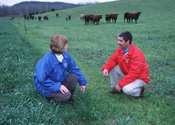 April
15, 2005—USDA is seeking public comment on national priorities and emerging
issues for its largest conservation program—the Environmental Quality Incentives
Program (EQIP). A national public listening session will be held May 5, 1 p.m.
to 3 p.m. in Room 107A, Whitten Building, USDA, 1400 Independence Ave., S.W., in
Washington, D.C. Both written and oral comments will be accepted at the session;
with written comments accepted through June 5. The national public listening
session culminates similar sessions held in all 50 states, the Caribbean Area
and the Pacific Basin over the last several months. USDA-NRCS will use the
information gathered from the sessions to prepare for the 2006 program year. April
15, 2005—USDA is seeking public comment on national priorities and emerging
issues for its largest conservation program—the Environmental Quality Incentives
Program (EQIP). A national public listening session will be held May 5, 1 p.m.
to 3 p.m. in Room 107A, Whitten Building, USDA, 1400 Independence Ave., S.W., in
Washington, D.C. Both written and oral comments will be accepted at the session;
with written comments accepted through June 5. The national public listening
session culminates similar sessions held in all 50 states, the Caribbean Area
and the Pacific Basin over the last several months. USDA-NRCS will use the
information gathered from the sessions to prepare for the 2006 program year.
Links…
NRCS news release: "USDA Seeks Public Comment on National Priorities, Emerging
Issues for Environmental Quality Incentives Program" (April 15, 2005)
Environmental Quality
Incentives Program
NRCS Offers Tribal and Asian Pacific Islander
Scholarships
 April
5, 2005—The NRCS 2005 Tribal Scholars Program and Asian Pacific Islander (API)
Scholars Program application period is April 4 through May 13. This is the first
year tribal scholarships have been offered. They will be awarded to U.S.
citizens who are seeking a degree in agriculture or related natural resource
sciences at a 1994 tribal land-grant institution. API scholarships are open to
U.S. citizens at universities with high percentages of Asian and Pacific
Islander students in California, Hawaii, Minnesota, Wisconsin and the Pacific
Basin. NRCS also participates in two USDA-sponsored scholarship programs: the
USDA/1890 National Scholars Program and the (Hispanic) Public Service Leaders
Scholarship. April
5, 2005—The NRCS 2005 Tribal Scholars Program and Asian Pacific Islander (API)
Scholars Program application period is April 4 through May 13. This is the first
year tribal scholarships have been offered. They will be awarded to U.S.
citizens who are seeking a degree in agriculture or related natural resource
sciences at a 1994 tribal land-grant institution. API scholarships are open to
U.S. citizens at universities with high percentages of Asian and Pacific
Islander students in California, Hawaii, Minnesota, Wisconsin and the Pacific
Basin. NRCS also participates in two USDA-sponsored scholarship programs: the
USDA/1890 National Scholars Program and the (Hispanic) Public Service Leaders
Scholarship.
Links…
NRCS news release: “USDA Offers
Tribal and Asian Pacific Islander Scholarships; Applications Accepted April 4
through May 13, 2005” (April 5, 2005)
NRCS Scholarship Programs
USDA Highlights 2004 Performance and Benefits of
Conservation Programs
 April
4, 2005—Agriculture Secretary Mike Johanns announced major conservation
achievements in 2004 resulting from USDA voluntary conservation programs for
private lands. NRCS offers producers technical and financial assistance to help
them develop more effective conservation plans that improve the environment and
help rural communities. Information on 2004 performance for NRCS conservation
programs, including national and state level data, is available on the Web. Key
programs highlighted are the Conservation Security Program, Environmental
Quality Incentives Program, Farm and Ranch Lands Protection Program, Grassland
Reserve Program, Wetlands Reserve Program, Wildlife Habitat Incentives Program,
Agricultural Management assistance and Conservation Reserve Program. April
4, 2005—Agriculture Secretary Mike Johanns announced major conservation
achievements in 2004 resulting from USDA voluntary conservation programs for
private lands. NRCS offers producers technical and financial assistance to help
them develop more effective conservation plans that improve the environment and
help rural communities. Information on 2004 performance for NRCS conservation
programs, including national and state level data, is available on the Web. Key
programs highlighted are the Conservation Security Program, Environmental
Quality Incentives Program, Farm and Ranch Lands Protection Program, Grassland
Reserve Program, Wetlands Reserve Program, Wildlife Habitat Incentives Program,
Agricultural Management assistance and Conservation Reserve Program.
Links…
 news release: “Johanns
Lauds Voluntary Conservation on Private Lands” (April 4, 2005)
en Español news release: “Johanns
Lauds Voluntary Conservation on Private Lands” (April 4, 2005)
en Español
"Looking to the Future of
Conservation," remarks at the National Association of Conservation Districts
Spring Legislative Conference, Washington, D.C.
(Bruce I. Knight, Chief, NRCS)
NRCS conservation programs
FY-2004 NRCS
conservation program allocations to states
Conservation Reserve
Program
NRCS Data Show Significant Gains in Ag Wetland
Acreage
 |
| Wetland in northern Iowa. |
March 31, 2005—NRCS announced agricultural wetland net gains of about 263,000
acres between 1997 and 2003. Results are based on new data in the National
Resources Inventory (NRI), an annual statistical survey of land use and natural
resource conditions and trends on U.S. nonfederal lands. NRI data show that
since 1997 annual wetland losses on all lands have been on a decline, while
annual agricultural wetland gains have been increasing.
Links…
NRCS news release: “NRCS Data Show
Significant Gains in Agricultural Wetland Acreage” (March 31, 2005)
en Español
National Resources Inventory
Wetlands-2002 Annual NRI
USDA Announces New Tool for Estimating Soil Carbon Sequestration
 March 23, 2005—NRCS is offering farmers and ranchers a new online management
tool called COMET-VR that provides a simple and reliable method for estimating
soil carbon sequestration. Storing, or “sequestering,” carbon in soil as organic
matter and in trees helps reduce the amount of carbon dioxide in the atmosphere.
COMET-VR was field tested by individuals involved in crop production, livestock
grazing and conservation planning in Colorado, Georgia, Illinois, Ohio, Texas
and Wyoming. March 23, 2005—NRCS is offering farmers and ranchers a new online management
tool called COMET-VR that provides a simple and reliable method for estimating
soil carbon sequestration. Storing, or “sequestering,” carbon in soil as organic
matter and in trees helps reduce the amount of carbon dioxide in the atmosphere.
COMET-VR was field tested by individuals involved in crop production, livestock
grazing and conservation planning in Colorado, Georgia, Illinois, Ohio, Texas
and Wyoming.
Links…
NRCS news release: “USDA Carbon Management Tool to Help Farmers and Ranchers with
Soil Carbon Sequestration” (March 23, 2005)
en Español
 news release
“New Greenhouse Gas Reporting Guidance for Farms and Forests”
(March 23, 2005) news release
“New Greenhouse Gas Reporting Guidance for Farms and Forests”
(March 23, 2005)
COMET-VR
USDA Greenhouse Gas Reporting Guidelines
DOE Voluntary Reporting of Greenhouse Gases Program 1605(b)
2005 Annual Conference on Carbon Sequestration, May 2-5, Alexandria VA
NRCS air quality information
NRCS Provides $3.2 Million for Natural Disaster
Recovery in Utah
 March
22, 2005—NRCS is providing $3.2 million in Emergency Watershed Protection
Program (EWP) funding to help restore natural resources and protect property
damaged by recent flooding in Washington County, Utah. This is in addition to $6
million for emergency environmental restoration work in Utah that USDA announced
on Feb. 1, 2005. Earlier this year, heavy rains caused severe flooding along the
Santa Clara River in southwestern Utah. NRCS will provide EWP assistance to
stabilize streambanks and remove debris. March
22, 2005—NRCS is providing $3.2 million in Emergency Watershed Protection
Program (EWP) funding to help restore natural resources and protect property
damaged by recent flooding in Washington County, Utah. This is in addition to $6
million for emergency environmental restoration work in Utah that USDA announced
on Feb. 1, 2005. Earlier this year, heavy rains caused severe flooding along the
Santa Clara River in southwestern Utah. NRCS will provide EWP assistance to
stabilize streambanks and remove debris.
Links…
 news release:
“USDA
Provides $3.2 Million for Natural Disaster Recovery Efforts in Utah” (March 22,
2005) news release:
“USDA
Provides $3.2 Million for Natural Disaster Recovery Efforts in Utah” (March 22,
2005)
Emergency Watershed Protection Program
Flooding in Utah
USDA Announces Sign-Up for 2005 Conservation Security
Program
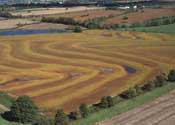 March
17, 2005—USDA announced that the 2005 sign-up for the Conservation Security
Program will be March 28 to May 27 in 220 watersheds nationwide. These
watersheds represent more than 185 million acres in every state and the Caribbean
area. The 2005 CSP sign-up includes the 202 watersheds announced by USDA on Nov.
2, 2004, and the 18 pioneer watersheds from the fiscal year 2004 sign-up.
Producers who have a current CSP contract are not eligible for this sign-up. The
sign-up announcement and an amendment to the CSP interim final rule that will
detail specific program requirements will be published in the Federal Register
soon. March
17, 2005—USDA announced that the 2005 sign-up for the Conservation Security
Program will be March 28 to May 27 in 220 watersheds nationwide. These
watersheds represent more than 185 million acres in every state and the Caribbean
area. The 2005 CSP sign-up includes the 202 watersheds announced by USDA on Nov.
2, 2004, and the 18 pioneer watersheds from the fiscal year 2004 sign-up.
Producers who have a current CSP contract are not eligible for this sign-up. The
sign-up announcement and an amendment to the CSP interim final rule that will
detail specific program requirements will be published in the Federal Register
soon.
Links…
 news release:
“Johanns Announces Sign-Up, Expansion, Amendment to Interim Final Rule for 2005
Conservation Security Program” (March 17, 2005)
en Español news release:
“Johanns Announces Sign-Up, Expansion, Amendment to Interim Final Rule for 2005
Conservation Security Program” (March 17, 2005)
en Español
Conservation Security Program
2005 Watershed Information
Conservation Security Program
USDA Announces $6 Million for New
Initiative for Limited Resource Farmers
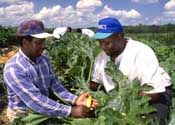 |
| South Carolina farmer harvests
squash on a family farm. |
March 15, 2005—NRCS is providing $6 million for a new
Small-Scale/Limited Resource Farmers Initiative to help small farmers overcome
barriers they face in reaching their conservation goals. The funds will help
farmers with 100 acres or less of cropland implement conservation practices.
NRCS in Alabama, Arkansas, Florida, Georgia, Kentucky, Louisiana, Mississippi,
North Carolina, South Carolina, Tennessee, Virginia and the Caribbean Area each
will dedicate up to $500,000 in appropriate program funds for the initiative.
Links…
 news release: “USDA Announces $6 Million for New Small-Scale/Limited
Resource Farmers Initiative” (March 15, 2005)
en Español news release: “USDA Announces $6 Million for New Small-Scale/Limited
Resource Farmers Initiative” (March 15, 2005)
en Español
Small, Limited Resource and Beginning
Farmers/Ranchers Assistance from NRCS
Small Farms@USDA
List of
Alternative Crops & Enterprises for Small Farm Diversification
NRCS Provides $6.9 Million for Natural
Disaster Recovery in California
 |
| Credit: Santa Paula Times
Online; photo by Pat Quinn, Santa Paula Airport |
March 8, 2005—NRCS is providing $6.9 million in Emergency
Watershed Protection Program (EWP) funding to help southern California recover
from recent severe storms and flooding. In Ventura County, two projects needing
immediate attention are along Santa Paula Creek and the Santa Paula Airport
where there is significant infrastructure damage. EWP projects provide sound
erosion control measures that are economically and environmentally defensible.
Links…
 news release:
“USDA Provides $6.9 Million for Natural Disaster Recovery in
California” (March 8, 2005)
en Español news release:
“USDA Provides $6.9 Million for Natural Disaster Recovery in
California” (March 8, 2005)
en Español
Emergency Watershed Protection Program
NRCS Natural Disaster Assistance in
California
NRCS Provides $2.8 Million to Restore
Salmon Habitat in Six States
 |
| photo courtesy of U.S. Army
Corps of Engineers Walla Walla District |
February 24, 2005—NRCS is providing $2.8 million in fiscal year
2005 Wildlife Habitat Incentives Program (WHIP) Salmon Habitat Restoration
Initiative funds to restore and conserve salmon habitat in Alaska, California,
Idaho, Maine, Oregon and Washington. This is the second year of the Initiative
that helps landowners with projects that restore habitat for Pacific and
Atlantic salmon.
Links…
 news release:
“USDA
Provides $2.8 Million to Restore and Conserve Salmon Habitat in Six States”
(February 24, 2005)
en Español news release:
“USDA
Provides $2.8 Million to Restore and Conserve Salmon Habitat in Six States”
(February 24, 2005)
en Español
Wildlife Habitat Incentives Program
NRCS Provides $9.3 Million for Natural
Disaster Recovery in 12 States
 Feb.
23, 2005—NRCS is providing $9.3 million in Emergency Watershed Protection
Program (EWP) funding for locally-sponsored watershed protection projects
resulting from recent floods and other natural disasters such as tornadoes,
fires, drought and hurricanes. States receiving the emergency funds are Alabama,
Arizona, California, Illinois, Indiana, Mississippi, Nevada, Oklahoma,
Pennsylvania, South Carolina, Tennessee and Texas. EWP projects provide sound
erosion control measures that are economically and environmentally defensible. Feb.
23, 2005—NRCS is providing $9.3 million in Emergency Watershed Protection
Program (EWP) funding for locally-sponsored watershed protection projects
resulting from recent floods and other natural disasters such as tornadoes,
fires, drought and hurricanes. States receiving the emergency funds are Alabama,
Arizona, California, Illinois, Indiana, Mississippi, Nevada, Oklahoma,
Pennsylvania, South Carolina, Tennessee and Texas. EWP projects provide sound
erosion control measures that are economically and environmentally defensible.
Links…
 news release:
“USDA Provides $9.3 Million for Natural Disaster Recovery in 12 States”
(Feb. 23, 2005) news release:
“USDA Provides $9.3 Million for Natural Disaster Recovery in 12 States”
(Feb. 23, 2005)
Emergency Watershed Protection Program
USDA and Smithsonian Present Soils Display
 Feb.
16, 2005—NRCS and the Smithsonian Institution will showcase a soils display at
the National Museum of Natural History in Washington, DC, that features a soil
monolith and introduces visitors to an expanded soils exhibit. This
first-of-its-kind exhibit will help educate millions of children and adults
annually about the nation’s soil resources and their economic value to a
productive and vibrant society. NRCS soil scientists, the Soil Science Society
of America and others have been working with Smithsonian exhibit designers on a
display of soil monoliths from every state. The first soil monolith going on
display features Menfro, the official Missouri state soil. The display of state
soil monoliths will become part of a larger interactive exhibit with hands-on
activities, demonstrations and an underground view of the hidden world of soil. Feb.
16, 2005—NRCS and the Smithsonian Institution will showcase a soils display at
the National Museum of Natural History in Washington, DC, that features a soil
monolith and introduces visitors to an expanded soils exhibit. This
first-of-its-kind exhibit will help educate millions of children and adults
annually about the nation’s soil resources and their economic value to a
productive and vibrant society. NRCS soil scientists, the Soil Science Society
of America and others have been working with Smithsonian exhibit designers on a
display of soil monoliths from every state. The first soil monolith going on
display features Menfro, the official Missouri state soil. The display of state
soil monoliths will become part of a larger interactive exhibit with hands-on
activities, demonstrations and an underground view of the hidden world of soil.
Nixa soil monolith. A soil monolith is a thick slice of soil extending down from
the surface deep into the subsoil. NRCS image.
Links…
 news release:
“USDA and Smithsonian Institution Present Soils Display”
(Feb. 16, 2005)
en Español news release:
“USDA and Smithsonian Institution Present Soils Display”
(Feb. 16, 2005)
en Español
Soils Exhibit information and
artist’s design concept
Information sheet on soil monoliths, soil
series and soil profiles
NRCS Helping People Understand Soils website
NRCS Salutes America’s Farmers and Ranchers on National Ag
Day
 March
20th is National Ag Day for 2005. Agriculture Secretary Mike Johanns delivered
the keynote address at the National Agriculture Day Luncheon, March 17, at the
National Press Club in Washington DC. The luncheon kicked off the National Ag
Day celebration and National Ag Week, March 20-26, 2005. Each year, local, state
and national events are held to raise awareness of the significance of U.S.
agriculture in our national and global economies. NRCS provides leadership in a
partnership effort to help people conserve, maintain and improve our natural
resources and environment. During fiscal year 2004, NRCS helped producers
develop conservation system plans on 12.7 million acres of cropland and 25.1
million acres of grazing land, and apply forest stand improvement and tree and
shrub establishment on nearly 620,000 acres. March
20th is National Ag Day for 2005. Agriculture Secretary Mike Johanns delivered
the keynote address at the National Agriculture Day Luncheon, March 17, at the
National Press Club in Washington DC. The luncheon kicked off the National Ag
Day celebration and National Ag Week, March 20-26, 2005. Each year, local, state
and national events are held to raise awareness of the significance of U.S.
agriculture in our national and global economies. NRCS provides leadership in a
partnership effort to help people conserve, maintain and improve our natural
resources and environment. During fiscal year 2004, NRCS helped producers
develop conservation system plans on 12.7 million acres of cropland and 25.1
million acres of grazing land, and apply forest stand improvement and tree and
shrub establishment on nearly 620,000 acres.
Links…
National Agriculture Day
U.S. Department of Agriculture
This document requires Adobe Acrobat
Reader
 NRCS
Accomplishments Report for FY 2004 NRCS
Accomplishments Report for FY 2004
NRCS Provides $10.7 Million to
Restore Illinois Wetlands; Formalizes Partnership with The Nature Conservancy
 Feb.
18, 2005—NRCS will provide $10.7 million to help restore a vast area of Illinois
wetlands through the Wetlands Reserve Program (WRP) and will establish a
framework of cooperation through an agreement with The Nature Conservancy.
Called the Emiquon Project, this 7,000-acre tract of land along the Illinois
River in Fulton County is one of the largest floodplain restoration projects in
the country. The WRP project will restore approximately 6,400 acres of wetlands.
A national memorandum of understanding between NRCS and the Conservancy
formalizes the partnership and establishes a framework to collaborate on
mutually-agreed upon activities. Feb.
18, 2005—NRCS will provide $10.7 million to help restore a vast area of Illinois
wetlands through the Wetlands Reserve Program (WRP) and will establish a
framework of cooperation through an agreement with The Nature Conservancy.
Called the Emiquon Project, this 7,000-acre tract of land along the Illinois
River in Fulton County is one of the largest floodplain restoration projects in
the country. The WRP project will restore approximately 6,400 acres of wetlands.
A national memorandum of understanding between NRCS and the Conservancy
formalizes the partnership and establishes a framework to collaborate on
mutually-agreed upon activities.
Links…
 news release
“USDA
Provides $10.7 Million to Restore and Protect Wetlands in Illinois” (Feb. 18,
2005)
en Español news release
“USDA
Provides $10.7 Million to Restore and Protect Wetlands in Illinois” (Feb. 18,
2005)
en Español
Wetlands Reserve Program
The Nature Conservancy
New Conservation Technical Assistance Policy Released
 Feb.
15, 2005—NRCS has a new comprehensive policy for operating the Conservation
Technical Assistance Program (CTA) that is the foundation for how USDA provides
on-the-ground conservation assistance to customers. Through CTA, NRCS helps
people voluntarily conserve, improve and sustain natural resources on their
land. The new CTA policy establishes national priorities for the program that
focus on helping producers comply more easily with environmental regulatory
burdens. Feb.
15, 2005—NRCS has a new comprehensive policy for operating the Conservation
Technical Assistance Program (CTA) that is the foundation for how USDA provides
on-the-ground conservation assistance to customers. Through CTA, NRCS helps
people voluntarily conserve, improve and sustain natural resources on their
land. The new CTA policy establishes national priorities for the program that
focus on helping producers comply more easily with environmental regulatory
burdens.
Links…
NRCS news release “USDA Announces New
Conservation Technical Assistance Policy”
(Feb. 15, 2005)
en Español
Conservation Technical Assistance Program
President’s Budget Supports Cooperative
Conservation
 Feb.
9, 2005—NRCS Chief Bruce Knight represented USDA at a joint press conference
with the Interior and Commerce departments and EPA. Officials discussed
President Bush’s continued commitment to cooperative conservation in his 2006
budget. Cooperative conservation supports programs that promote partnerships
with the American people to conserve our nation’s land and water, wildlife and
other natural resources. Feb.
9, 2005—NRCS Chief Bruce Knight represented USDA at a joint press conference
with the Interior and Commerce departments and EPA. Officials discussed
President Bush’s continued commitment to cooperative conservation in his 2006
budget. Cooperative conservation supports programs that promote partnerships
with the American people to conserve our nation’s land and water, wildlife and
other natural resources.
Links…
 news release
“President Bush Reinforces Commitment to Cooperative Conservation in 2006
Budget” (Feb. 9, 2005) news release
“President Bush Reinforces Commitment to Cooperative Conservation in 2006
Budget” (Feb. 9, 2005)
NRCS conservation programs
NRCS partnerships
USDA Awards More Than $22 Million to 17
States
 Feb.
9, 2005—USDA announced that $22.2 million in Environmental Quality Incentives
Program funds would be provided to 17 states for their high levels of
performance in implementing the program. These funds will help farmers and
ranchers improve soil, air and water resources on private working lands. States
receiving the performance award are Alabama, Arkansas, Georgia, Idaho,
Louisiana, Maine, Mississippi, Montana, New Mexico, North Dakota, Ohio,
Oklahoma, South Carolina, Texas, Utah, Washington and Wyoming. Feb.
9, 2005—USDA announced that $22.2 million in Environmental Quality Incentives
Program funds would be provided to 17 states for their high levels of
performance in implementing the program. These funds will help farmers and
ranchers improve soil, air and water resources on private working lands. States
receiving the performance award are Alabama, Arkansas, Georgia, Idaho,
Louisiana, Maine, Mississippi, Montana, New Mexico, North Dakota, Ohio,
Oklahoma, South Carolina, Texas, Utah, Washington and Wyoming.
Links…
 news release
“USDA Awards More Than $22 Million in Environmental Quality Incentives Program
Funds to 17 States” (Feb. 9, 2005)
en Español news release
“USDA Awards More Than $22 Million in Environmental Quality Incentives Program
Funds to 17 States” (Feb. 9, 2005)
en Español
Environmental Quality Incentives Program
NRCS Pilots State-Level Grant
Competitions in 12 States and the Pacific Basin
 Feb.
8, 2005—NRCS will conduct pilot state-level Conservation Innovation Grant (CIG)
competitions in fiscal year 2005 in California, Colorado, Iowa, Louisiana,
Mississippi, Montana, Nebraska, New Hampshire, New Jersey, New Mexico, North
Dakota, Texas and the Pacific Basin. Funding availability and detailed
application and submission information for the distinct state-level competitions
will be announced through public notices, separate from the national program.
CIG provides farmers and ranchers with the opportunity, through innovation, to
address some of the country’s most pressing natural resource conservation needs. Feb.
8, 2005—NRCS will conduct pilot state-level Conservation Innovation Grant (CIG)
competitions in fiscal year 2005 in California, Colorado, Iowa, Louisiana,
Mississippi, Montana, Nebraska, New Hampshire, New Jersey, New Mexico, North
Dakota, Texas and the Pacific Basin. Funding availability and detailed
application and submission information for the distinct state-level competitions
will be announced through public notices, separate from the national program.
CIG provides farmers and ranchers with the opportunity, through innovation, to
address some of the country’s most pressing natural resource conservation needs.
Links…
NRCS news release “USDA Pilots Conservation
Innovation Grants State-Level Competitions in 12 States and the Pacific Basin”
(Feb. 8, 2005)
en Español
Conservation Innovation Grants
NRCS Chief Outlines the Future of Conservation
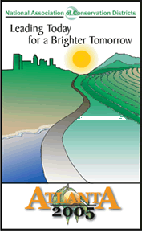 |
 |
| Chief Knight speaks at 59th
Annual NACD meeting |
Feb. 7, 2005—NRCS Chief Bruce Knight addressed attendees at the National
Association of Conservation Districts (NACD) 59th Annual Meeting held February
5-10 in Atlanta, Ga. In his remarks, Chief Knight addressed the future of
conservation and the power of partnerships. NACD, a primary NRCS partner,
promotes conservation through nearly 3,000 conservation districts nationwide.
“2005 marks NRCS’s 70th anniversary. Over the years, NRCS has worked with NACD
and many conservation partners to build a strong conservation legacy on private
lands throughout the United States,” Knight said.
Links…
"Charging into the Future: The NRCS of the
Future," remarks at the 59th Annual Meeting of the National Association of
Conservation Districts Atlanta, GA (Bruce I. Knight, Chief, NRCS)
NACD 59th Annual Conference
NRCS Partnerships
NRCS Provides Emergency Watershed
Protection Funds to Utah
 Feb.
1, 2005—Agriculture Secretary Mike Johanns announced that $6 million will be
available through the Emergency Watershed Protection Program for Washington
County, Utah. The funding will provide emergency assistance to help restore
natural resources and protect property from the devastating effects of recent
flooding in that area. EWP funds are used for activities such as debris removal,
streambank stabilization and revegetation. Feb.
1, 2005—Agriculture Secretary Mike Johanns announced that $6 million will be
available through the Emergency Watershed Protection Program for Washington
County, Utah. The funding will provide emergency assistance to help restore
natural resources and protect property from the devastating effects of recent
flooding in that area. EWP funds are used for activities such as debris removal,
streambank stabilization and revegetation.
Links…
 news release
“Emergency Watershed Protection Program Funding Will Help Washington County,
Utah” (Feb. 1, 2005)
en Español news release
“Emergency Watershed Protection Program Funding Will Help Washington County,
Utah” (Feb. 1, 2005)
en Español
Emergency Watershed
Protection Program
Flooding in Utah
Up to $5 Million Available for Grants
in the Chesapeake Bay Watershed
 Jan.
31, 2005—NRCS is providing up to $5 million in fiscal year 2005 Conservation
Innovation Grants (CIG) for the Chesapeake Bay watershed that covers more than
64,000 square miles extending over parts of six states: Delaware, Maryland, New
York, Pennsylvania, Virginia and West Virginia. Agricultural lands make up
nearly one-third of the watershed. CIG is offered to a variety of potential
applicants to help develop, test, implement and transfer innovative
environmental solutions. A request for proposals is on the NRCS and federal
eGrants websites. Applicants have 60 days to submit proposals. Jan.
31, 2005—NRCS is providing up to $5 million in fiscal year 2005 Conservation
Innovation Grants (CIG) for the Chesapeake Bay watershed that covers more than
64,000 square miles extending over parts of six states: Delaware, Maryland, New
York, Pennsylvania, Virginia and West Virginia. Agricultural lands make up
nearly one-third of the watershed. CIG is offered to a variety of potential
applicants to help develop, test, implement and transfer innovative
environmental solutions. A request for proposals is on the NRCS and federal
eGrants websites. Applicants have 60 days to submit proposals.
Links…
 news release
“USDA Provides Up to $5 Million in Conservation Innovation Grants for the
Chesapeake Bay Watershed” (Jan. 31, 2005)
en Español news release
“USDA Provides Up to $5 Million in Conservation Innovation Grants for the
Chesapeake Bay Watershed” (Jan. 31, 2005)
en Español
Conservation Innovation Grants
This document requires Adobe Acrobat
Reader
 CIG
Chesapeake Bay request for proposals CIG
Chesapeake Bay request for proposals
NRCS To Continue Support of
Greater Sage Grouse Habitat Conservation
 Jan.
13, 2004—NRCS will continue support of greater sage grouse habitat efforts
through voluntary conservation programs, employee training and partnership
activities. The U.S. Fish and Wildlife Service announced on Jan. 7 that the
greater sage grouse does not warrant protection under the Endangered Species
Act. USDA-NRCS is one of several federal agencies that supports voluntary
greater sage grouse habitat enhancement. NRCS allocated $2.4 million for greater
sage grouse conservation in fiscal year 2004 and expects to exceed that amount
in fiscal year 2005. Jan.
13, 2004—NRCS will continue support of greater sage grouse habitat efforts
through voluntary conservation programs, employee training and partnership
activities. The U.S. Fish and Wildlife Service announced on Jan. 7 that the
greater sage grouse does not warrant protection under the Endangered Species
Act. USDA-NRCS is one of several federal agencies that supports voluntary
greater sage grouse habitat enhancement. NRCS allocated $2.4 million for greater
sage grouse conservation in fiscal year 2004 and expects to exceed that amount
in fiscal year 2005.
Links…
NRCS news release "USDA To
Continue Support of Greater Sage Grouse Habitat Conservation" (Jan. 13,
2005)
en Español
Grasslands Reserve Program
Wildlife Habitat Incentives Program
Nation’s First Grassland Reserve Program
Easement Completed
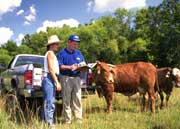 Jan.
13, 2005—USDA announced that the nation’s first conservation easement completed
in the Grassland Reserve Program (GRP) is located on 83 acres of grassland in
Sumter County, S.C. NRCS worked with Rowland Alston, the landowner, to develop a
grassland resources conservation plan that will maintain the viability of a
perennial stand of mixed grasses through common grazing practices such as
rotational grazing and cross fencing. GRP, administered by NRCS, Farm Service
Agency and the Forest Service, emphasizes protection for grasslands that are
under threat of conversion to cropland or other uses. Jan.
13, 2005—USDA announced that the nation’s first conservation easement completed
in the Grassland Reserve Program (GRP) is located on 83 acres of grassland in
Sumter County, S.C. NRCS worked with Rowland Alston, the landowner, to develop a
grassland resources conservation plan that will maintain the viability of a
perennial stand of mixed grasses through common grazing practices such as
rotational grazing and cross fencing. GRP, administered by NRCS, Farm Service
Agency and the Forest Service, emphasizes protection for grasslands that are
under threat of conversion to cropland or other uses.
Links…
 news release
“USDA
Announces the Nation’s First Conservation Easement in the Grassland Reserve
Program” (Jan. 13, 2005)
en
Español news release
“USDA
Announces the Nation’s First Conservation Easement in the Grassland Reserve
Program” (Jan. 13, 2005)
en
Español
Grassland Reserve Program
NRCS South Carolina
Up to $15 Million Available for
Conservation Innovation Grants and Final Rule Released—Proposals Due March 28,
2005
 Jan.
11, 2005—The Conservation Innovation Grants (CIG) final rule has been released
and up to $15 million made available to promote public-private partnerships that
provide innovative technologies and approaches to environmental enhancement and
protection on working agricultural lands. The final rule describes a national
competition and a corresponding state-level competition. CIG is offered to a
diverse set of potential applicants, including state and local agencies,
nonprofit organizations, for-profit companies, tribes and individuals, to help
develop, test, implement and transfer innovative environmental solutions. The
CIG final rule was published in today’s Federal Register and the request for
proposals is on the NRCS and federal eGrants websites. Jan.
11, 2005—The Conservation Innovation Grants (CIG) final rule has been released
and up to $15 million made available to promote public-private partnerships that
provide innovative technologies and approaches to environmental enhancement and
protection on working agricultural lands. The final rule describes a national
competition and a corresponding state-level competition. CIG is offered to a
diverse set of potential applicants, including state and local agencies,
nonprofit organizations, for-profit companies, tribes and individuals, to help
develop, test, implement and transfer innovative environmental solutions. The
CIG final rule was published in today’s Federal Register and the request for
proposals is on the NRCS and federal eGrants websites.
Links…
 news release
“USDA Provides Up to $15 Million and Releases Final Rule for Conservation
Innovation Grants” (Jan. 11, 2005) news release
“USDA Provides Up to $15 Million and Releases Final Rule for Conservation
Innovation Grants” (Jan. 11, 2005)
en
Español
Conservation Innovation Grants
CIG Final Rule
CIG Request for Proposals
CIG on Federal eGrants
| |
|
